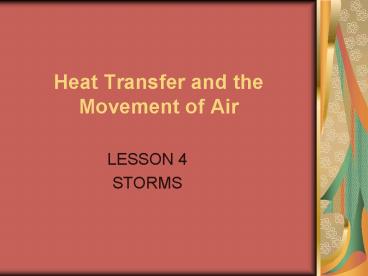Heat Transfer and the Movement of Air - PowerPoint PPT Presentation
1 / 21
Title:
Heat Transfer and the Movement of Air
Description:
3. Draw a diagram in the space below showing what happened when you introduced ... The hot air rose quickly. The air looked wispy and light. Light, less dense ... – PowerPoint PPT presentation
Number of Views:126
Avg rating:3.0/5.0
Title: Heat Transfer and the Movement of Air
1
Heat Transfer and the Movement of Air
- LESSON 4
- STORMS
2
OBJECTIVES
- Investigate the effect of surface temperature on
the temperature of the air above the surface. - Hypothesize how heat is transferred between the
earths surface and the air above it. - Observe describe the effect of surface
temperature on the movement of air above the
surface
3
OBJECTIVES
- Determine the basic conditions under which water
moves through the air. - Develop working definitions for the terms stable
air mass and unstable air mass
4
Inquiry 4.1 Investigating the Temperature of Air
- Demo of Experimental Setup
- See Figure 4.1 pg. 44
- See Figure 4.2 pg. 45
5
Fair Test
- HOW WOULD YOU MAKE THIS EXPERIMENT A FAIR TEST?
- VARIABLES THAT WILL REMAIN THE SAME
- AMT. OF WATER
- ATM OF TIME EA. CONTAINER OF WATER IS UNDER THE
CONVECTION TUBE - AMT OF TIME BET. TEMP READINGS
6
PREDICTION
- THE SURFACE TEMPERATURE IN THE CONVECTION TUBES
WILL CAUSE THE AIR ABOVE IT TO.
7
HYPOTHESIS
- I THINK THAT WILL OCCUR BECAUSE..
8
(No Transcript)
9
Student Sheet 4.2 Investigating How Warm and
Cold Air Move Question I will try to
answer Directions Answer the questions. Then
complete the diagram after you conduct your
investigation. 1. How will you set up your
equipment in order to make this a fair test?
What will you keep the same?
What one variable will you test? 2.
Now make a prediction. What do you think will
happen when the two air masses meet?
3. Draw a diagram in the space below showing
what happened when you introduced smoke into
the tube.
10
VARIABLE THAT WILL CHANGE
- TEMPERATURE OF WATER IN EACH CONTAINER
11
(No Transcript)
12
REFLECTION 4.1
- A. How did the temperature of each
- container of water affect the
- temperature of the air above it?
- Hot water heated air directly above it
- Cold water cooled air directly above it
13
Reflection Question B
- The movement of heat is called heat transfer.
Describe the heat transfer between the container
of hot water air. - Heat moved from warm water to the cooler air ,
which heated the air - Describe the heat transfer between the container
of cold water the air. - Heat moved from the warm air to the cooler
water, which heated the water cooled the air
14
Reflection Question C
- Under what conditions was it difficult to see
through a cylinder? Why do you think this
happened? - The tube with hot water fogged up because
moisture formed on the inside of the convection
tube. - More condensation took place with hot water
because of greater evaporation
15
Reflection Question D
- Why do you think covering the container would
help keep the cylinder clear? - The plastic would reduce evaporation by blocking
the escape of water vapor
16
REFLECTIONS 4.2
- A. ON THE BASIS OF YOUR TEMPERATURE READINGS IN
INQUIRY 4.1, HOW DOES THE TEMPERATURE OF A
SURFACE AFFECT THE TEMPERATURE OF THE AIR ABOVE
IT? - Air takes on the temperature of the SURFACE below
it.
17
- B. HOW DID THE AIR, WHICH WAS VISIBLE BECAUSE OF
THE SMOKE, MOVE IN THE CONVECTION TUBE WHEN THE
WATER UNDER IT WAS COLD? EXPLAIN WHY YOU THINK
THIS HAPPENED. - 1. The cold air moved down.
- 2. The air looked thick and heavy.
- 3. Heavy, dense air sinks.
18
- C. WHAT HAPPENED TO THE AIR INSIDE THE
CONVECTION TUBE WHEN THE WATER WAS HOT? EXPLAIN
WHY YOU THINK THIS HAPPENED. - The hot air rose quickly
- The air looked wispy and light
- Light, less dense air rises
19
- D. WHY DO YOU THINK MOISTURE FORMED ON THE
INSIDE OF THE CONVECTION TUBE WITH HOT WATER?
HOW DO YOU THINK THIS RELATES TO CLOUD FORMATION
ON EARTH? - The energy needed to evaporate water came from
the hot water. When water vapor rises to high
altitudes where the air is cold, it changes into
liquid or ice (Condensation) The process of
liquid changing to water is called evaporation.
20
- E. APPLY WHAT YOU OBSERVED IN LESSON 4 TO THE
EARTH. IF THE EARTHS SURFACE IS COLD, WHAT WILL
HAPPEN TO THE AIR ABOVE IT? IF THE SURFACE IS
HOT WHAT WILL HAPPEN TO THE AIR ABOVE IT? - The air above an area of the earth where it is
cold will be colder. The air above a warm area
will be warmer.
21
Read pg. 49 Air Masses































